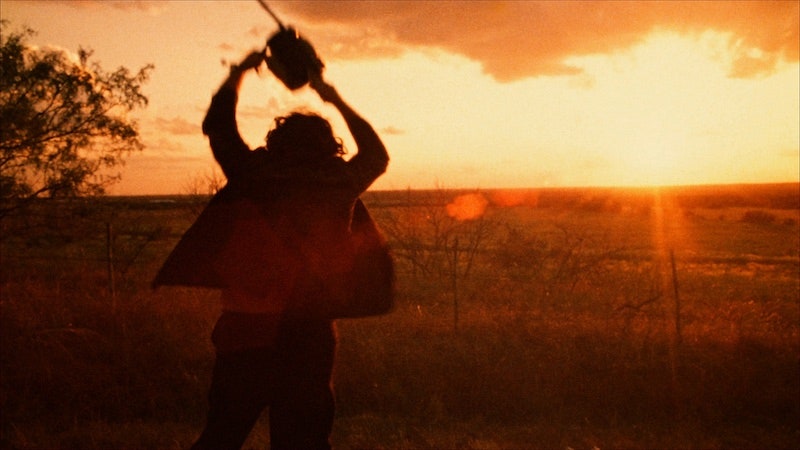
Save this storySave this storySave this storySave this story
It begins with not one, not two, but three prologues, each spiked with a different kind of horror. First, a scrolling text suggesting that this all really happened to the “five youths” we are about to meet, even though it didn’t. Second, glimpses of cadavers in oily Caravaggio light, culminating in a long, sociopathically calm shot of the ruined graveyard where they’ve been dug up. Third, footage of solar flares, combined with reports of nationwide disaster. What the sun has to do with anything on Earth will never be explained, though it seems significant that when we meet our five fatted calves they’re talking about astrology. (Seventies horror movies, from “Jaws” to “Invasion of the Body Snatchers,” were full of chirpy, vaguely countercultural types.) We also learn that they are driving to the little town of Newt, Texas, out of concern for ancestors who were buried in that graveyard, because what could be more virtuous than caring for your family, in death as in life?
Being such a decent bunch, the group stops to pick up a hitchhiker, who turns out to be twangy-voiced, obsessed with meat, and deranged. His family once worked at the local slaughterhouse, but their jobs have been automated into oblivion, leaving them with nothing but nostalgia for their old day-to-day. To turn a cow into food, he says, “they take the head and they boil it, except for the tongue, and scrape all the flesh away from the bone. They use everything—they don’t throw nothing away!” Explaining all this to a van full of permed, bell-bottomed city kids seems to excite him almost as much as it disgusts them, and it may disgust you, too. But in the world of “The Texas Chain Saw Massacre”—which may, even fifty years on, just be the world—killing and looking out for your family are so closely tied as to be almost the same.
Famous horror directors tend to get pestered for origin stories. Being polite people, for the most part, they usually oblige, which is how I know that an elementary-school bully named Fred Kruger beat up Wes Craven, the six-year-old Alfred Hitchcock was sent to an actual jail cell, and little Brian De Palma used to visit the hospital where his father worked to giggle at the gore. When Tobe Hooper died, in 2017, having directed several worthy films but only one “Texas Chain Saw Massacre,” various juicy-sounding bits made the rounds. Growing up in Austin, he met a doctor who mentioned a Halloween mask made from human flesh. An aunt in Wisconsin told him about Ed Gein, the killer who converted corpses into lampshades. Years later, he was on the U.T. Austin campus the day an ex-marine named Charles Whitman climbed to the top of the clock tower and murdered passersby with a hunting rifle. He was rattled by the image of his mother having a lung removed.
The implication of these kinds of stories, or, at least, of the media’s demand for them, is that horror requires some deep psychological wound, that you’d choose to spend your life scaring people only because something scary happened to you first. There may be a dribble of truth in this, though nobody seems to demand similar explanations from, say, action directors. It’s especially ironic in Hooper’s case; few modern horror films are less interested in psychological backstory than “The Texas Chain Saw Massacre.” We’re told next to nothing about the victims’ relationships with one another, or their lives back home. No childhood trauma lurks behind the killers the way it does for Norman Bates or Michael Myers. If any -ology helps us understand these people, it’s sociology: assembly-line slaughter makes the underclasses deranged; technology makes them irrelevant; unemployment makes them hungry. Scarcity underlies almost everything the characters do, whether they’re killers or not—like that other stagflation classic, “Mad Max,” this is a story about precious fuel and the lengths some people will go to get it. The youths discover a household of cannibals because their van is low on gas and they hear a generator somewhere. Later, one of the cannibals takes care to switch off all the lights in his store—power bills being enough to “drive a man outta business”—before going off to feast on the alternative energy source he and his family have discovered.
Scarcity was an apt theme for Hooper’s film, which cost something like a hundred and forty thousand dollars to make, and features a community theatre’s worth of small-timers and first-timers. The shoot was probably illegal a dozen times over: the narrator who reads the scrolling prologue text had to be paid in weed, and the art director, unable to afford prop animal carcasses, drove around picking up actual skulls and roadkill. A graduate student named Gunnar Hansen was cast as the masked, lumbering Leatherface, the cannibal family’s designated executioner. Since there was no money for a backup costume, he wore the same clothes seven days a week, for up to sixteen hours a day, while the weather hovered around a hundred degrees Fahrenheit. I get the sense, listening to interviews with some of the actors, that they consider the rest of their lives a vacation.
The film’s first half hour strides curtly forward, doling out the who and the where and the what, with occasional twitches of lyricism in between—a dead armadillo by the side of the highway, say, or a long, mournful shot of the van as it drives off to certain doom. You can’t learn about how this film was made without gagging, but you can’t watch the results without marvelling: not one frame or line or sound effect goes to waste, since Hooper couldn’t afford any, and this gives everything a tautness that you sense somewhere in the gut before the mind catches up. Throwaway lines about barbecue and cuddly animals and planets in retrograde are, naturally, not throwaway at all, a point the script makes comically obvious when Franklin, who uses a wheelchair, asks his sister Sally, the only youth who’ll survive, if she believes in astrology. She replies, “Everything means something, I guess.”
Decades of bickering about the violence in the film—some viewers insisting that it’s too bloody, others that most of the blood is in our imaginations—has distracted from its visual beauty. This seems important to stress, since beauty, along with sociology, is what Hooper gives us in lieu of direct answers. When one of the youths walks through the cannibals’ house, she finds a room full of remains, some animal and some human. It’s an astonishing sequence, only two minutes long but seemingly an hour, scored to the clucks of a caged chicken, and stuffed with closeups of skulls intercut with the woman’s face so as to suggest one about to become the other. What’s astonishing isn’t only the lushness that Hooper finds in this deathly place. (I’ve thought too much about a certain shot of sunlight shining through a translucent bone.) It’s the fact that we seem to be looking at decorations—that, somewhere between killing and eating, these people have spared the time to make their house look prettier, for no other reason than to make their lives a little less miserable.
So far, I haven’t really talked about why “The Texas Chain Saw Massacre” is frightening, but in scenes like this it becomes not only frightening but haunting. The usual things we’re invited to take comfort in during a horror movie—the stability of the household, the loved ones who live there—are here just another piece of the horror. Who, we might ask, is this film’s true villain? Does it even have one? Leatherface does most of the killing but takes no obvious pleasure in it, and in any case Hooper instructed Hansen to play the character as mentally disabled. The hitchhiker does seem to relish the cannibal life style, but notice, too, how well his attentiveness to his grandfather, who seems unable to walk, contrasts with the way the city kids tease Franklin for a similar condition. Toward the end of the film, it is the hitchhiker who drags Sally to his elder and invites him to kill her with a hammer, apparently because the frail old man enjoys this kind of thing and could use some excitement. In how many other films is the most frightening act one of the few compassionate ones?
Extinction seems likely for these cannibals, but, a half century later, “The Texas Chain Saw Massacre” has sired a vast brood of art-house and grind-house films. Stanley Kubrick, a superfan, must have been thinking of Hooper when he conceived of those moments in “The Shining” when the ghosts drink and dance. I sense more Hooper, by way of Kubrick, in Jordan Peele’s three films so far, with their knack for scattering little clues about racism and surveillance and consumerist apathy as though the monsters onscreen are representatives of much looser, deadlier forces. I also can’t help but wonder if Cormac McCarthy, decades away from “No Country for Old Men,” was paying attention when the hitchhiker explains that the slaughterhouse has switched to killing cattle with an air gun. (De Palma, at some pre-“Body Double” date, certainly was.)
On the grind-house end of things, Hooper is still celebrated, when he’s not being reviled, for inspiring an avalanche of hardware-store butchery and final girls. The second trope is a curious one, because in nearly every later film to make use of it the female lead is rewarded for being clever or kind or virginal or brave or, if she’s Jamie Lee Curtis in “Halloween,” all of the above. There is no obvious reason that Hooper chooses Sally to survive the carnage—her brother is the far more likable, fleshed-out character. She gets lucky, and that is all. When the cannibals are preparing to kill her, there is an unforgettable closeup of her wide, bloodshot eye, which is both the window to the soul and just another potential source of energy, like gasoline, itself just the remainder of million-year-old plants, which get their energy from the big, yellow fireball in the sky. Everything, in this grim astrology, means something, and that something is fuel. And, at that point, there is nothing to do but run, very fast, to the highway and hope that the pickup truck on the horizon brakes for hitchhikers. ♦
Sourse: newyorker.com






